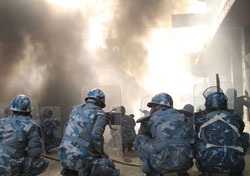|
|
This was always an improbable nation state. Situated on the debris of the collision of two continents 65 million years ago, it is also where southern Asia's linguistic, cultural, ethnic, and religious quadrants meet. With 109 ethnic groups and at least 93 languages, Nepal is the most heterogeneous country in the region. And discard the myth that we are a 'small country'. With Nepal's population soon crossing 30 million it is going to be the 40th most populous in the world.
String together geology, diversity, and demography and what you have is a country that looks ungovernable. No wonder 19th century colonisers left us alone. With literacy and political empowerment, and especially after April 2006, Nepal's ethno-linguistic and geographically marginalised are clamouring for rights and autonomy.
The 20 border districts of the tarai now have nearly half of Nepal's population. But this strip of the plains is not homogenous either. More than one-third of the people there are made up of hill and mountain cohorts who moved down and have lived there for generations. (See: 'Nepalis want to stand up and be counted', #332) Madhesis of various castes are 40 percent, the indigenous Tharus are 14 percent, and Muslims make up nearly nine percent.
The tarai never got political representation in Kathmandu based on its population ratio. Under the Panchayat, token madhesis were given positions and after 1990, hill-dominated parties did the same with party tickets. Madhesis feel the interim constitution continues the discrimination. If the breakdown were fair, the legislature would effectively have 112 members from madhesi and other tarai groups instead of the 41 members in the House dissolved last week.
The troubles in the tarai can be resolved quickly by guaranteeing proportional representation now. Otherwise Wednesday's bushfire from Janakpur (see picture) will spread across the plains. The issue must be resolved through compromise and it is the neglect of the issue by the 7+1 parties in Kathmandu that is opening up this festering wound. This apathy has resulted in political forces competing with each other to be more radical than the other and stake their claim for madhesi leadership: the two ex-Maoist JTMM factions, two NSP splinters, madhesis from within the NC and UML, and even royalist madhesis. Royal residues working with religious extremists from across the border to provoke tarai anger is making matters worse.
Every Nepali, except the aboriginal groups, is the descendant of migrants. How far back in history do we want to go? Let's not squander our hard- won freedom for the second time since 1990.



